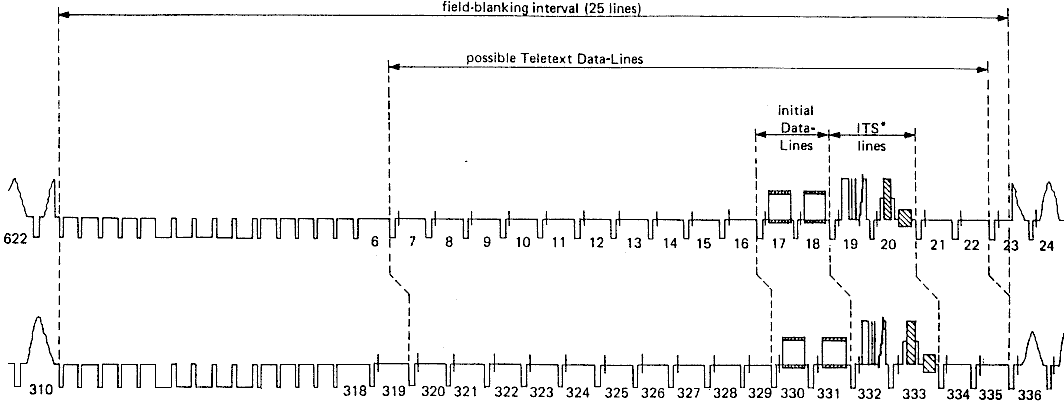
| Introduction | Price £1 September 1976 Published jointly by the |
1a. Hamming Code Bytes 1b. Hamming codes - tests for odd parity 1c. Hamming codes - decoding action 2. Display Modes and Control Characters 3. Teletext Character Codes
This document describes the parameters of the Teletext signals transmitted in the United Kingdom by the BBC and the Independent Television Networks. It supercedes earlier specifications. The BBC uses the name Ceefax and the Independent Television Companies use the name Oracle for their public information services. The technical specifications of the Oracle and Ceefax signals are identical.
Based on experience gained in the initial years of the transmissions, changes have been made since the first specification published in October 1974. Additional Control Characters have been allocated to pprovide facilities which can be used to enhance the display of information. The changes have been made in such a way that future transmissions remain compatible with Teletext decoders based on the later specification dated January 13th 1976.
Distortions, noise and spurious signals inevitably degrade the signal to a greater or lesser extent. An important point to note is that an increase in the magnitude of these effects will cause a gradual deterioration in analogue television while a digital signal, such as Teletext, can still be decoded until the disturbances exceed a critical level. Field studies have confirmed that in almost all cases this critical level for Teletext occurs when television reception is already poor.
This document defines the Teletext broadcasting system. Much of the detailed information is carried by figure and tables. The description is in four sections.
The first section describes how binary code groups are formed into Data-Lines for inclusion in the television field blanking interval.
The second section describes how the control and address information carried on each Data-Line, together with the special Page-Header Data-Lines and the sequence of transmission of the Data-Lines, allow the Data-Lines corresponding to the Rows of a selected Page to be identified.
The third section describes how the Character Codes received on the Data-Lines corresponding to the Rows of the selected Page are interpreted to give the Page display.
The fourth section defines Teletext terms.
The television signal includes unused lines in the field-blanking interval (see figure 1) to allow time for field flyback in receivers before each active field begins. The duration of this interval is usually 25 lines, and some of the later lines are used by broadcasters for test and signalling purposes.
This system can use any of the unused lines as Data-Lines. Initially lines 17 (330) and 18 (331) are being used but other lines may be used.
A line in the field-blanking interval is identified as a Teletext Data-Line by the presence of the clock run-in (see 1.2.1) followed by the Framing Code (see 1.2.2) at an appropriate time.
Each Data-Line contains binary digits (bits) as a two-level NRZ (Non-Return-to-Zero) signal, suitably shaped by a filter.
The binary signalling levels are defined on a scale where television black level is 0% and white level 100% (see figure 2). The binary '0' level is then 0 (±2)% and binary '1' level is 66(±6)%. The difference between these levels is the basic data amplitude. The data waveform will contain overshoots so the peak-to-peak amplitude will exceed the basic data amplitude. The basic data amplitude may vary from Data-Line to Data-Line.
The bit signalling rate is 6.9375 Mbits/s (±25 parts per million). It is 444 times the nominal television line frequency.
The data timing reference point is the peak of the penultimate '1' of the Clock Run-In Sequence (see figure 3). This point has been selected to reduce the effect of any transient distortions at the start of the Data-Line.
The line time reference is the half-amplitude point of the leading edge of the line synchronisation pulse.
The data timing reference in the signal as transmitted shall be 12.0 (+0.4/-1.0) µs after the line time reference.
The data timing may vary from Data-Line to Data-Line.
The spectrum of the generated data pulses, which is the product of the spectrum of the basic NRZ data waveform and that of a phase-corrected shaping filter, is indicated in figure 4. To minimise intersymbol interference the spectrum is substantially skew-symmetrical about a frequency corresponding to one-half of the bit rate. There is minimal energy above 5.0 MHz.
The corresponding one-bit pulse is indicated in figure 5.
Each Data-Line comprises 360 bits which may be considered as 45 eight-bit bytes.
The first three bytes, which have even parity, serve to synchronise the bit and byte recovery operation in the receiver. The remaining 42 bytes have odd parity and carry addresses and control information, and the codes for a character Row (see figure 6).
The use of odd parity during the variable part of the Data-Line ensures that there are never more than 14 bit periods between the data level transitions in the wave form. This simplifies the recovery of the bit-rate clock directly from the data waveform.
All the address and Page control information is transmitted using Hamming Code Bytes to reduce the possibility of the wrong Character Rows being stored in the receiver.
The first two Bytes of every Data Line comprise the Clock Run-In sequence of alternating bits, beginning 101010... to indicate the presence of a Data-Line and to establish the timing of bits on that line (see figure 6)
In some circumstances the first one or two binary '1's may be absent.
The third Byte of every Data-Line comprise the Framing Code 11100100. This code has been selected to enable Byte synchronisation to be even if one bit of the Framing Code has been wrongly received.
Figure 9 indicates how incoming data are compared with the Framing Code pattern. It shows that a test for any seven corresponding bits will give a correct indication of the Framing Code in the presence of a single error.
The fourth and fifth Byte of every Data-Line, and a further eight Bytes of the Page-Header Data Lines, are Hamming Codes containing four 'message' bits as listed in table 1a. The bits are transmitted in numerical order from b1 to b8.
Table 1b details four parity tests that can be made on the received Byte and detect multiple errors (when 2,4, or 6 bits are in error). When there are 3, 5, 7 or 8 errors in the Byte this procedure results in a false message being decoded.
Figure 6 shows the locations and lists the functions of all the Hamming 'message' bits. When error correction is used the decoded message bit may differ from the corresponding bit in the Data-Line as the bits of the Hamming Code are interdependent.
The remaining Bytes of each Data-Line are seven-bit Character Codes (see table 3) with an added odd-parity bit b8. The bits are transmitted in numerical order from b1 to b8.
Every Data-Line contains two Hamming Coded signifying a three-bit Magazine number and a five-bit Row address (see figure 6).
The Magazine number is in the range 1 to 8, magazine 8 corresponding to the bits 000 and the others being directly obtained with the bit weights given in figure 6.
The Row address is normally in the range 0 to 23, and it is the number directly obtained with the bit weights given in figure 6. Row addresses in the range 24 to 31 may be transmitted but such Data-Lines must be ignored.
Data-Lines with Row address 0 are Page-Headers, which contain eight additional Hamming Code bytes with message bits relating to that Page, including the two digits of the Page number and the four-digit Time Code (see figure 6). The display and control functions of the other message bits are detailed in 2.3 below.
Each Page is identified by its single-digit Magazine number (1-8) and its two-digit Page number (00-99).
Different Pages with the same Magazine and Page numbers may be identified by invoking a four-digit Time Code whereby up to 32000 versions of that Page may be individualy selected and held.
The 'Hours' and 'Minutes' of the Time Code are not necessarily related to clock-time. The 'Hours Tens' may take any value 0 to 3 and the 'Minutes Tens' may take any value 0 to 7.
A Page may be selected by its Magazine number and Page number, or by its Magazine number, Page number and Time Code.
Neither type of Page selection should respond to Page number 'Units' or 'Tens' in the range 10 to 15, and selection by Time Code should not respond to 'Minutes Units' or 'Hours Units' in that range, which may be used for other purposes.
The transmission of a selected Page begins with, and includes, its Page-Header and ends with, and excludes, the next Page-Header of the selected Magazine number. All the intermediate Data-Lines carrying the selected Magazine number relate to the selected Page.
Pages may be transmitted in any order. Occasionally incomplete Pages may be transmitted. Rows from Pages of different magazine number may be interleaved in time.
The Rows of a Page begins may be transmitted in any order. Rows, including the Page-Header, may be repeated in which case the latest apparently error-free information should take precedence. Rows containing no information for display need not be transmitted.
Rows will be transmitted such as to allow an active television field period between an initial Page-header and further Rows sufficient to complete the transmission for that page.
This allows one display period for the receiver Page store to be erased when necessary.
The Page-Header Data-Lines (see 2.1.2) contain eight Hamming Code Bytes in place of the first eight Character Bytes of the other Data-Lines (see figures 6 and 7).
There are thus only 32 Character Codes in a Page-Header. They are used to present general information for display, such as the Magazine and Page number, the day and the date and the programme source. In particular, the last eight characters are reserved for the display of clock-time. Examples of the content of a Page Header are given in figure 7a.
| C4 | Erase Page. This Control Bit is set to
'1' when the information on that page is significantly
diferent from that in a previous transmission of the Page
bearing the same Magazine and Page number, such that the
two should not be confused. Its use will alwas be followed by a Page Erasure interval (see 2.2.3). |
| C5 | Newsflash Indicator. This Control Bit is set to '1' on a page designated as a 'Newsflash' Page, whether or not it currently contains information. All information intended for display on such a Page wil be Boxed (see 3.1.5). |
| C6 | Subtitle Indicator. This Control Bit is set to '1' on a Page designated as a 'Subtitle' Page, whether or not it currently contains information. All information intended for display on such a Page wil be Boxed (see 3.1.5). |
| C7 | Suppress Header. This Control Bit is set to '1' when the Page is better displayed without the characters of the Page-Header |
| C8 | Update Indicator. This Control Bit may be set to '1' when when part or all of a Page contains later information than that of the previous transmission of the Page bearing the same Magazine and Page number. The 'Update' Page transmission may be incomplete, containing only the updated Rows of a Page (see 2.2.1). |
| C9 | Interrupted Sequence. This Control Bit
is set to '1' when a Page is transmitted out of strict
numerical sequence in order to give it priority (such as
a Subtitle Page) or more frequent transmission (such as
an Index Page). It allows the Page Header to be suppressed when Rolling Headers are displayed, to avoid discontinuities in the displayed Page numbers. |
| C10 | Inhibit Display. This Control Bit is set to '1' when contents of a Page cannot be usefully interpreted as a Teletext transmission. It can be used to inhibit the display of meaningless Pages. |
| C11 | Magazine Serial. This Control Bit is set to '1' when the transmission sequence of Magazines and Pages is such that it is preferable to display all Page-Headers as Rolling Headers rather than only those of the selected Magazine. |
| C12 C13 C14 |
Unallocated. It is desirable that these unallocated Control Bits be accessible in decoders for future use as display control functions. |
The 24 Rows of a Page are numbered sequentially from 0 (Page-Header, top Row) to 23. The 40 Character Rectangles of a row are directly related to the 40 Character Bytes of the corresponding Data-Line, each being assumed to be scanned sequentially from left to right (see figure 7).
Each Character Byte contains a Character Code which represents either a Display Character or a Control Character. The Control Characters are used to establish Display Modes, which may be changed between Character Rectangles within a Row.
The Display Modes determine how a Display Character is interpreted as a character to be generated in the corresponding Character Rectangle of the Page Display. The Character Rectangles corresponding to Control Character Codes are generally displayed as Spaces (but see 3.1.7).
The Display Modes are listed in table 2 as complementary pairs; those on the left are assumed at the start of every Row. The Control Character Codes listed with each mode are used to initiate that mode.
Some Control Characters have immediate effect ('set at') in that the new module obtains for and from the corresponding Character Rectangle, others have subsequent effect ('set after') when the new mode obtains for and from the next Character Rectangle. A later Control Character takes precendence over an earlier one.
When a Control Characters signifies a change to a mode already obtaining, that mode generally continues uninterrupted throughout the corresponding Character Rectangle (but see 3.1.3).
In general the Character Codes of a Row are sufficient to define the entire display of that Row (but see 3.1.6).
The interpretation of the Display Modes is detailed below.
Three overlapping sets of 96 Display Characters are available for interpretation of the 96 Display Character Codes.
During the Alphanumerics Mode the Alphanumerics Set applies. During the Graphics Mode the Contiguous Set applies during the Contiguous Mode and the Separated Set applies during the Separated Mode.
One of the seven colours white, yellow, cyan, green, magenta, red, blue is used to depict the Display Character in the Character Rectangle. Seven pairs of Control Characters are available so that the Display Colour and/or the Alphanumerics/Graphics Mode may be changed by a single Control Character. There is a direct correspondence between bits b1, b2, b3 of these codes and the red, green and blue components of these colours.
The Background Colour of the Character Rectangles is black during the Black Background mode. Whenever a new background Control Character 1/13 (see table 3) occurs the Display Control then obtaining is adopted as the Background Colour in thhe new Background mode.
One of the seven colours white, yellow, cyan, green, magenta, red, blue is used to depict the Display Character in the Character Rectangle. Seven pairs of Control Characters are available so that the Display Colour and/or the Alphanumerics/Graphics Mode may be changed by a single Control Character. There is a direct correspondence between bits b1, b2, b3 of these codes and the red, green and blue components of these colours.
Two modes are provided wherein the display Characters are displayed as Spaces at certain times. All characters in the Conceal mode are displayed as Spaces until the Reveal mode is restored after a time delay in the receiver or by user control. All characters in the Flash mode are displayed alternately as they would otherwise be displayed, and as Spaces, under the control of a timing device in the receiver.
All characters intended for display on Newsflash and Subtitle Pages will be in the Boxed Mode, which define the part of the Page which is to be inset into normal television picture. This inset operation may be controlled automatically by the Control Bits C5 or C6 (see 2.3.1).
Some or all of the characters on any other Pages may be Boxed, the Boxed Mode then defines a part of the Page which may be inset into the normal television picture under user control as an alternative to the display of the complete Page alone, or superimposed on the picture.
In order to give protection against spurious Boxing, two consecutive Start Box Control Characters 0/11 (see table 3) will be transmitted to start the Boxed Mode and two consecutive End Box Control Characters 0/10 will be transmitted to terminate that mode. The mode changes occur between the corresponding consecutive Character Rectangles
Whenever the Double Height mode occurs the information in that Row is sufficient to define the display both that Row and the Row of next higher address. A receiver responding to the Double Height mode on a Row must ignore any information received for the Row of next higher address, but a receiver not responding to this mode will operate normally on both Rows.
A receiver responding to one or more occurences of the Double Height mode in Row 'R' will operate as otherwise during that Row except that in every Character Rectangle during the Double Height mode only the upper half of what would otherwise have been displayed is displayed, stretched vertically to fill the rectangle. On Row 'R+1' the corresponding lower half of each of these is similarly displayed. The remaining Character Rectangles of Row 'R+1' are to be displayed as unboxed spaces of the same Background colour as the corresponding Character Rectangles of Row 'R'.
Generally all Control Characters are displayed as Spaces, implying at least one space between rectangles with different Display Colours in the same Row. The Hold Graphics mode allows a limited range of abrupt display Display Colours by calling for the display of a Held Graphics Character in the rectangle corresponding to any Control Character occurring during the Graphics Mode. This Held Character is displayed in the modes obtaing for the rectangle in which it is display, except for the Contiguous/Separated Mode which forms part of the structure of the Held Graphics Character
The Held Graphics Character is only defined during the Graphics Mode. It is then the most recent character with b6=1 in its character code, providing that there has been no intervening change in either the Alphanumerics/Graphics or the Normal/Double Height modes. This character is to be displayed in the Contiguous/Separated Mode as when it was first displayed. In the absence of such a character the Held Graphics Character is taken to be a space.
Access Time The time between selecting a page at a receiver and the first complete reception of that page.
Alphanumerics Character One of the 96 Display Characters listed in columns 2,3,4,5,6, and 7 of Table 3. The shapes of the characters are not defined but should all be different and recognisable.
Alphanumerics Mode The Display Mode in which the Display Characters are those in the Alphanuerics Set.
Background Colour The colour filling the parts of the Character Rectangle not occupied by the character itself (see figure 8). The Background Colour may be black or any of the seven Display Colours. It may be changed within a Row by Control Characters.
Blast-Through Alphanumerics The use of the 32 Alphanumeric Characters of columns 4 and 5 of table 3 during the Graphics Mode.
Boxed Mode The Display Mode in which, under the user's control, the characters are intended to be inset or added to a television picture. When a Newsflash or Subtitle is transmitted this operation may be automatic under the control of Control Bits.
Broadcast Teletext The information broadcastings system defined in this document
Byte A group of eight consecutive data bits intended to be treated as an entity.
Character Byte The Byte obtained by appending an odd-parity bit to the Character Code.
Character Code A seven-bit binary number representing one of a set of Display Characters, or a Control Character.
Character Rectangle One of the 960 units in the regular matrix of 24 rows by 40 sites in which the characters are displayed on the screen.
Character Row See Row.
Clock Run-In A sequence of alternating bits at the start of a Data Line to allow a receiver to achieve bit synchronization.
Conceal A Display Mode during which all characters, although stored in the receiver, are displayed as spaces until the viewer chooses to reveal them.
Contiguous Graphics Set The set of 96 Display Characters comprising the 64 Contiguous Graphics Characters listed in columns 2a, 3a, 6a and 7a of table 3, together with the 32 Blast-Through Alphanumerics Characters of columns 4 and 5.
Contiguous Mode The Display Mode in which the six cells of the Graphics Characters fill the Character Rectangle (see figure 8).
Control Bits Each Page Header contains 11 Control Bits to control the display of the Page and its header (see 2.3.1).
Control Character One of the 32 characters listed in columns 0 and 1 of table 3. Five of these are reserved for compatibility with other data codes. The others are used to alter the Display Modes. They are usually displayed as Spaces (but see 3.1.7)
Data Line One of the otherwise unused lines in the television field blanking interval used to carry information for a Teletext Character Row. A Data Line is identified by the Clock Run-In sequence followed by a Framing Code at the appropriate time on a line in the field interval.
Display Character One of 222 different shapes which can be generated in a Character Rectangle as part of a Page. These are Alphanumerics Characters to provide text and Graphics Characters to provide elementary pictorial information. There are three sets: the Alphanumerics set, the Contiguous Graphics set and the Separated Graphics Set, each of 96 Display Characters, some of which are common.
Display Colour One of the seven colours (white, yellow, cyan, green, magenta, red, blue) used to depict a Dispaly Character against the Background Colour in a Character Rectangle. The Display Colour may be changed within a Row by Control Characters.
Display Mode The way in which the Character Codes corresponding to Display Characters are interpreted and displayed depends on Display Modes established by previous Control Characters (see table 2). These modes may be changed within a Row, and an initial set of modes is defined for the start of a Row.
Flash A display mode in which all character alternate as they would otherwise be displayed, and as Spaces, under the control of a timing device in the receiver.
Framing Code A Byte following the Clock Run-In sequence, selected to allow the receiver to achieve Byte synchronization even if one of its bits is wrongly decoded.
Graphics Character One of the 127 different Display Characters based on the division of the Character Rectangle into six cells, the cells being Contiguous or Separated. The corresponding Character Codes have B6=1; there is a direct correspondence between the other six bits of the code and the states of the six cells of the Character Rectangle. Examples are given in figure 8.
Graphics Mode The Display Mode in which the Display Characters are those of one or the other Graphics Sets, depending on whether the Contiguous or Separated mode is being used.
Hamming code AIn the Teletext system a Hamming Code is a Byte containing four message bits and four protection bits as indicated in table 1. A single-bit error in such a Byte can be corrected. Hamming Codes are used for sending addres and control information.
Hold Graphics A Display Mode in which any Control Character occurring during the Graphics Mode results in the display of a Held Graphics character (see 3.1.7).
Magazine A group of up to 100 numbered Pages, each carrying a common Magazine number in the range 1 to 8. Up to eight magazines may be transmitted in sequence or independently on a television programme channel.
Newsflash Page A Page in which all the information for display is Boxed, and Control Bit C5 is set to allow this information to be automatically inset or added to a television picture.
Page A group of up to 24 Rows of 40 characters intended to be displayed as an entity on the television screen.
Page Header A Page Header Data Line has Row address '0' and it separates the Pages of a Magazine in the sequence of transmitted Data Lines. In place of the first eight Character Bytes it contains Hamming Coded address and control information relating to that Page. Thus the top Row of the Page has only 32 Character Bytes. These are used for the transmission of general information such as Magazine and Page number, day and date, programme source and clock time.
Release Graphics The Display mMode in which Control Characters are invariably displayed as Spaces. It is complementary to the Hold Graphics Mode.
Reveal The Display Mode complementary to the Conceal Mode.
Rolling Headers The use of the top Row of the page to display all the Page Headers of the selected Magazine as they are transmitted. This gives an indication of the Page transmission sequence while the user is watching, or awaiting, a selected page.
Row A Page comprises 24 Rows of characters. When displayed on a television screen each row occupies about 20 television display lines. Each Row is generated from the information on one television Data-Line. It is to avoid confusion with television 'lines’ that the Teletext Pages are said to contain 'Rows'.
Row-Adaptive Transmission - Teletext transmission in which Rows containing no information are not transmitted. This reduces the access times of the system. The non-transmitted Rows are displayed as Rows of unboxed black spaces.
Separated Graphics Set - the set of 96 Display Characters comprising the 64 Separated Graphics Characters corresponding to the Contiguous Graphics Characters listed in columns 2a, 3a, 6a and 7a of table 3, together with the 32 Blast-Through Alphanumerics Characters of columns 4 and 5.
Separated Mode - the Display mode in which there is Background Colour boundary around and between the six cells of the Graphics Characters within the Character Rectangle (see figure 8).
Space - a Character Rectangle entirely filled by the background colours.
Subtitle Page - A Page in which all the information for the display is Boxed, and Control Bit C6 is set to allow this information to be automatically inset or added to the television picture.
Teletext - An information transmission system using the data and display formats described in sections 2 and 3 of this document.
Television Data Line See Data Line.
Time-Coded Page - In addition to a Magazine number and Page number a Page may be assigned a 'Time Code' of one of 3200 numbers arranged as two 'Hours' digits and two 'Minutes' digits. This code may be used to selct one of many Pages, bearing the same Magazine and Page number, transmitted in sequence. When the transmission of each version of the page is isolated or infrequent this code may be made literally the Hours' digits and two 'Minutes' of the clock-time at which it is transmitted.
Time Display - the last eight characters of every Page Header are reserved for clock-time. A receiver may be arranged to display these characters from the Rolling Headers to give a clock-time display.

* Insertion test signal
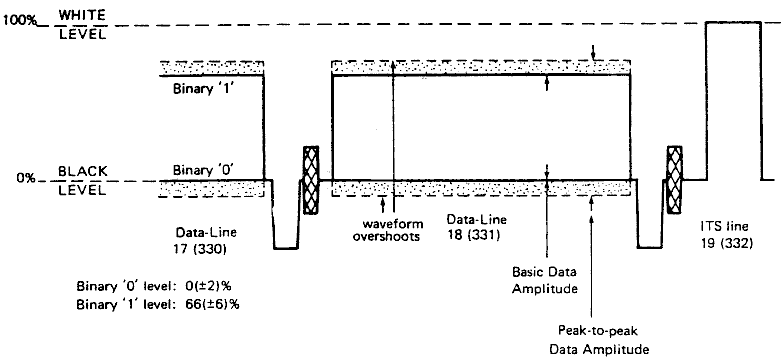
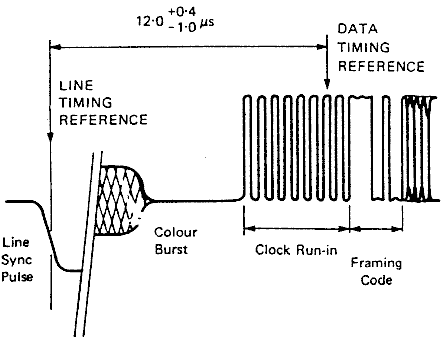
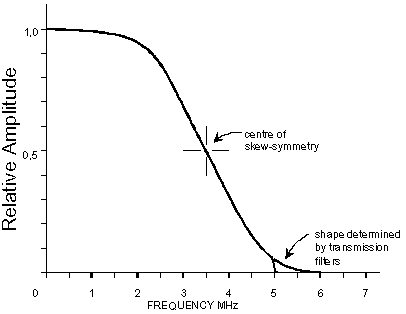
* based on practice current in September 1976
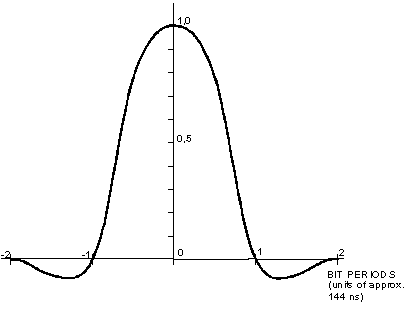
* based on practice current in September 1976
| Page Header (Row 0) | Clock Run-In |
Clock Run-In |
Framing Code |
Magazine and Row- address Group |
Eight Hamming Codes peculiar to Page Header | 32 Characters | |
| Row 1 | 40 Characters | ||||||
| Row 2 | |||||||
| Row 3 | |||||||
M = Message Bits
P = Protection Bits
C = Control Bits
| Synchronisation | Hamming Codes common to all Rows | ||||||||||||||||||||||||||||||||||||||
| Clock Run-in Sequence | Framing Code | Magazine Number |
Row Address |
||||||||||||||||||||||||||||||||||||
| .Clock Run-in | Clock Run-in | 20 | 21 | 22 | 20 | 21 | 22 | 23 | 24 | ||||||||||||||||||||||||||||||
| 1 | 0 | 1 | 0 | 1 | 0 | 1 | 0 | 1 | 0 | 1 | 0 | 1 | 0 | 1 | 0 | 1 | 1 | 1 | 0 | 0 | 1 | 0 | 0 | P | M | P | M | P | M | P | M | P | M | P | M | P | M | P | M |
C4 Erase.
C5 Newsflash
C6 Subtitle
C7 Suppress Header
C8 Update
C9 Interrupted Sequence
C10 Inhibit display
C11 Magazine Serial
C12, C13, C14 Unallocated
| Eight Hamming Codes peculiar to Page Header | |||||||||||||||||||||||||||||||||||||||||||||||||||||||||||||||||||||||
| Page number |
Time Code 'Minutes' |
Time Code 'Hours' |
Control | First character of Page Header |
|||||||||||||||||||||||||||||||||||||||||||||||||||||||||||||||||||
| Units | Tens | Units | Tens | Units | Tens | Group A | Group B | ||||||||||||||||||||||||||||||||||||||||||||||||||||||||||||||||
| 20 | 21 | 22 | 23 | 20 | 21 | 22 | 23 | 20 | 21 | 22 | 23 | 20 | 21 | 22 | C4 | 20 | 21 | 22 | 23 | 20 | 21 | C5 | C6 | C7 | C8 | C9 | C10 | C11 | C12 | C13 | C14 | ||||||||||||||||||||||||||||||||||||||||
| P | M | P | M | P | M | P | M | P | M | P | M | P | M | P | M | P | M | P | M | P | M | P | M | P | M | P | M | P | M | P | M | P | M | P | M | P | M | P | M | P | M | P | M | P | M | P | M | P | M | P | M | P | M | P | M | P | M | P | M | P | M | P | M | M | M | M | M | M | M | M | P |
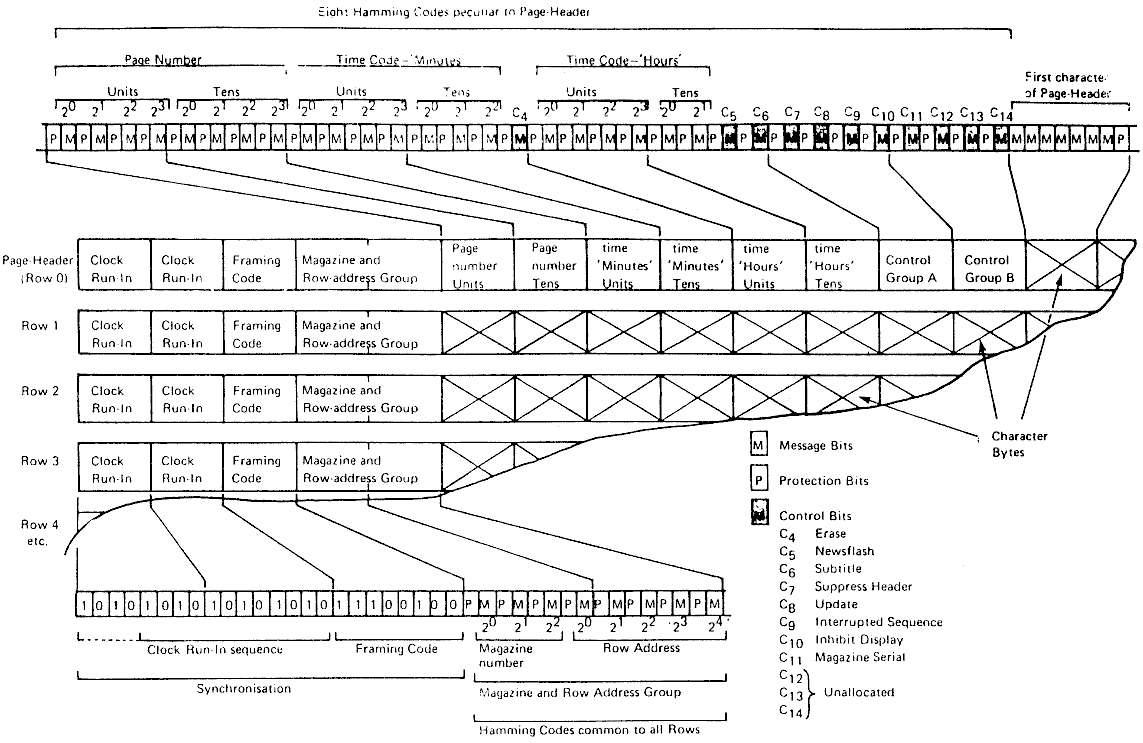
| Sync
bytes |
Address
and Control bytes |
Coded Characters for display | ||||||||||||||||||||||||||||||||||||||||||
| C R |
C R |
F C |
M R |
A G |
P U |
P T |
M U |
M T |
H U |
H T |
C A |
C B |
O | R | A | C | L | E | 3 | 0 | 9 | T | h | u | 19 | F | e | b | I | T | V | 1 | 4 | 0 | 5 | : | 3 | 4 | ||||||
| C | E | E | F | A | X | P | 3 | 0 | 9 | T | h | u | 1 | 9 | F | e | b | |||||||||||||||||||||||||||
| This block of 24
characters will normally contain the type of information shown. The format is not fixed and will be decided by the editors. Two possible examples are shown |
This block of 8 characters is reserved for the display of clock-time |
|||||||||||||||||||||||||||||||||||||||||||
| Sync
bytes |
Address bytes |
40 Coded Characters for display | ||||||||||||||||||||||||||||||||||||||||||
| C R |
C R |
F C |
M R |
A G |
N | o | w | i | s | t | h | e | t | i | m | e | f | o | r | a | l | l | g | o | o | d | m | e | n | t | o | c | o | m | e | |||||||||
0 0 0 0 0 1 0 0 0 0 1 0 1 1 1 1 0 0 0 1 0 1 1 0
| Alphanumeric
and Graphics 'Space' Character 00000100
|
Alphanumeric
Character 10110101
|
Alphanumeric
or Blast-Through Character 00010011
|
Alphanumeric
Character 11111110
|
| Contiguous Graphics Character 01101110
|
Separated Graphics Character 01101110
|
Separated Graphics Character 11111110
|
Contiguous Graphics Character 11111110
|
Key: White = background colour, Black = display colour
Note: Character Bytes are listed as transmitted from LSB to MSB
<-- Movement of data stream Data in
shift
registerNumber of corresponding bits .......0 10101010 4 Example with
12-bit
Run-In code
moving through
shift register......01 01010101 4 .....010 10101010 4 ....0101 01010101 4 ...01010 10101010 4 ..010101 01010101 4 Framing code
moving into
shift register.0101010 10101011 4 01010101 01010111 3 10101010 10101110 3 01010101 01011100 5 10101010 10111001 3 01010101 01110010 4 10101010 11100100 8 Framing code in shift register 01010101 1100100X <= 5 10101011 100100XX <= 4 01010111 00100XXX <= 6 10101110 0100XXXX <= 6 01011100 100XXXXX <= 6 10111001 00XXXXXX <= 6 01110010 0XXXXXXX <= 6 11100100 XXXXXXXX <= 7 ^^^^^^^^
||||||||11100100 Test word for comparison with
data in shift register
X's represent bits in the control and row address group
For clarity the framing code groups shown thus.
Diagram showing contents of shift register in each clock period.
MESSAGE BITS b8 b7 b6 b5 b4 b3 b2 b1 0
0
0
0
0
0
0
0
1
1
1
1
1
1
1
10
0
1
1
1
1
0
0
1
1
0
0
0
0
1
10
0
0
0
1
1
1
1
0
0
0
0
1
1
1
11
0
0
1
0
1
1
0
1
0
0
1
0
1
1
00
0
1
1
0
0
1
1
0
0
1
1
0
0
1
11
0
0
1
1
0
0
1
0
1
1
0
0
1
1
00
1
0
1
0
1
0
1
0
1
0
1
0
1
0
11
0
1
0
0
1
0
1
0
1
0
1
1
0
1
0PROTECTION BITS
b8 b7 b6 b5 b4 b3 b2 b1 A * * * * B * * * * C * * * * D * * * * * * * * * Tested bits
RESULTS OF
PARITY TESTSINFERENCE ACTION A,B,C D All Correct Correct No errors Accept message bits All Correct Not Correct Error in b7 Accept message bits Not All Correct Correct Multiple errors Reject message bits Not All Correct Not Correct Single error Refer to Table 1b to identify error.
Correct error if in message bit
| DISPLAY MODE | SET AT | SET AFTER | DISPLAY MODE | SET AT | SET AFTER | SEE SECTION | ||
| ALPHANUMERICS | Row Start | 0/1, 0/2, 0/3, 0/4, 0/5, 0/6, 0/7 |
GRAPHICS | - | 1/1, 1/2, 1/3, 1/4, 1/5, 1/6, 1/7 |
3.1.1 | ||
| CONTIGUOUS | Row Start, 1/9 * | 1/9 * | SEPARATED | 1/10 * | 1/10 * | 3.1.1 | ||
| DISPLAY COLOUR |
includes RED |
Row Start | 0/1, 0/3, 0/5, 0/7, 1/1, 1/3, 1/6, 1/7 |
DISPLAY COLOUR |
excludes RED |
- | 0/2, 0/4, 0/6 1/2, 1/4, 1/6 |
3.1.2 |
| includes GREEN |
Row Start | 0/2, 0/3, 0/6, 0/7, 1/2, 1/3, 1/6, 1/7 |
excludes GREEN |
- | 0/1, 0/4, 0/5 1/1, 1/4, 1/5 |
|||
| includes BLUE |
Row Start | 0/4, 0/5, 0/6, 0/7, 1/4, 1/5, 1/6, 1/7 |
excludes BLUE |
- | 0/1, 0/2, 0/3 1/1, 1/2, 1/3 |
|||
| BLACK BACKGROUND | Row Start, 1/12 | - | NEW BACKGROUND | 1/13 ** | 3.1.3 | |||
| REVEAL | Row Start, User Control *** |
0/1, 0/2, 0/3, 0/4, 0/5, 0/6, 0/7, 1/1, 1/2, 1/3 1/4, 1/5, 1/6, 1/7 |
CONCEAL | 1/8 | - | 3.1.4 | ||
| STEADY | Row Start | - | FLASH | - | 0/8 | 3.1.4 | ||
| UNBOXED | Row Start **** | 0/10 **** | BOXED | 0/11 **** | 0/1 **** | 3.1.5 | ||
| NORMAL HEIGHT | Row Start | - | DOUBLE HEIGHT | - | 0/13 | 3.1.6 | ||
| RELEASE | Row Start | 1/15 | HOLD | 1/14 | - | 3.1.7 | ||
* these codes may take effect 'at' or 'after' their occurrence
** whenever this code occurs the Display Colour is adopted as the
New Background colour
*** the Reveal mode may be maintained throughout a page by a user
control
**** two consecutive code are transmitted, the mode changes
between them
| b7..5 | 000 | 001 | 010 | 011 | 100 | 101 | 110 | 111 | ||||||
| b4..1 | 0 | 1 | 2 | 2a | 3 | 3a | 4 | 5 | 6 | 6a | 7 | 7a | <- Col | |
| 0000 | 0 | NUL(1) | DLE(1) | 0 | @ | P | p | |||||||
| 0001 | 1 | Alpha Red | Graphics Red | ! | 1 | A | Q | a | q | |||||
| 0010 | 2 | Alpha Green | Graphics Green | " | 2 | B | R | b | r | |||||
| 0011 | 3 | Alpha Yellow | Graphics Yellow | £ | 3 | C | S | c | s | |||||
| 0100 | 4 | Alpha Blue | Graphics Blue | $ | 4 | D | T | d | t | |||||
| 0101 | 5 | Alpha Magenta | Graphics Magenta | % | 5 | E | U | e | u | |||||
| 0110 | 6 | Alpha Cyan | Graphics Cyan | & | 6 | F | V | f | v | |||||
| 0111 | 7 | Alpha White (2) | Graphics White (2) | ' | 7 | G | W | g | w | |||||
| 1000 | 8 | Flash | Conceal display | ( | 8 | H | X | h | x | |||||
| 1001 | 9 | Steady (2) | Contiguous Gfx (2) | ) | 9 | I | Y | i | y | |||||
| 1010 | 10 | End Box (2) | Separated Gfx | * | : | J | Z | j | z | |||||
| 1011 | 11 | Start Box | ESC (1) | + | ; | K | k | ¼ | ||||||
| 1100 | 12 | Normal height (2) | Black Background (2) | , | < | L | ½ | l | || | |||||
| 1101 | 13 | Double height | New Background | - | = | M | m | ¾ | ||||||
| 1110 | 14 | S0 | Hold Graphics | . | > | N | n | ÷ | ||||||
| 1111 | 15 | S1 | Release Graphics (2) | / | ? | O | # | o | block | |||||
| Row | ||||||||||||||
Codes may be referred to by their column and row: e.g. 2/5 refers to %
(1) These control characters are reserved for compatibility
with other data codes
(2) These control characters are presumed before each row begins.
Black represents display foreground colour.
White represents display background colour.
The latest teletext spec allows codes 00 and 10 to be Alpha Black and Graphics Black respectively,
though cautions that some older equipment may interpret these code differently.
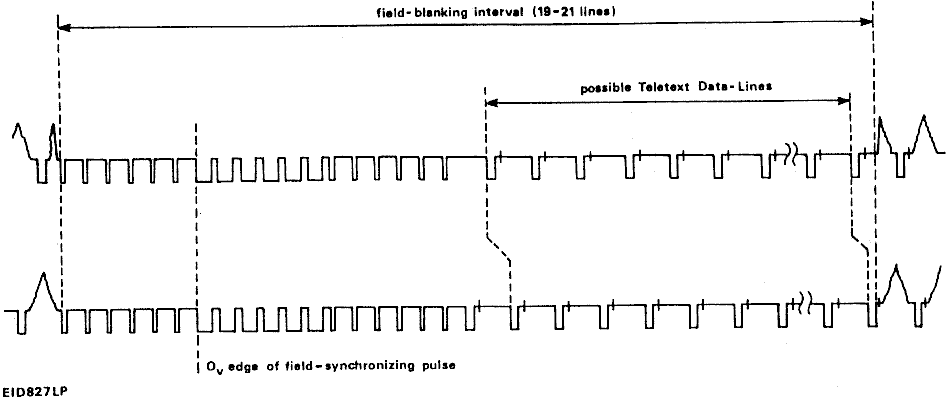
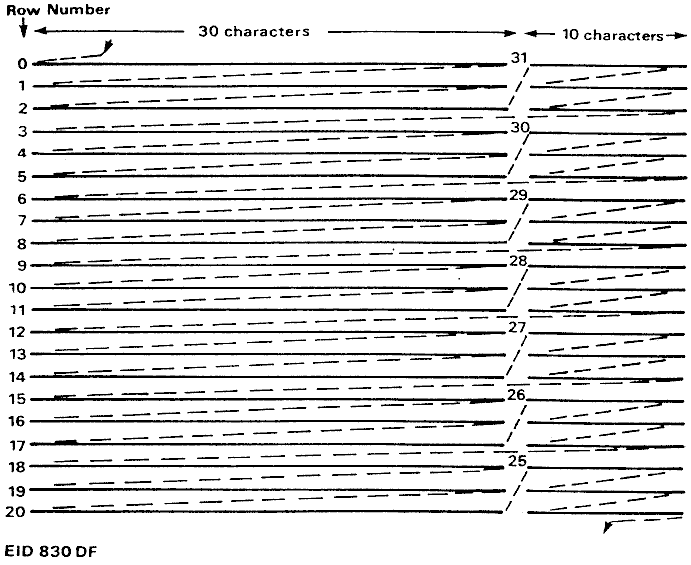
Numbers are ROW ADDRESSES in transmitted DATA LINE
This document describes considerations to be applied when adapting the UK specification for use with 525/60 television systems with band-widths of 4.0 MHz or greater. Sections of the UK specification are referred to and where there is no reference to a section, it is considered that it is directly applicable to 525/60 systems. In some cases a range of values is provided, since the final choice can only be made after field tests using braodcast transmitters and typical receiving sites, together with cable systems. By means of an example attention is particularly drawn to a method introduced to permit the transmission of a given Row of characters to be divided between two Data-Lines.
3.
An appropriate binary signalling rate directly applicable to
525/60 television systems with video band-widths of 4.0 MHz or
greater is likely to be between 3.8 and 5.7 Mbit/s. during each
Data-Line.
4.
Each Data-Line carries data synchronising and address information
and the codes for either the first part of a Row of characters or
the completion of a group of Rows of characters.
5.
In this example, a Page comprises twenty-one Rows of
forty characters, including a special top Row called the Page
Header.
8.
Using two Data-Lines per field, the system allows between three
and five full Pages/second to be transmitted, depending upon the
bit rate.
The television signal includes unused lines in the field blanking interval (see figure A attached) to allow time for field fly-back in receivers before each active field begins. The duration of this interval is 19-21 lines, some of which are used for test, signalling and other purposes.
This system can use any of these unused lines. A line In the field blanking interval is identified as a Teletext Data-Line by the presence of the Clock Run-In (see Section 1.2.1) followed by the Framing Code (see Section 1.2.2) at an appropriate time.
The binary element signalIing rate is recommended to be an even multiple of the nominal television line frequency, and is likely to be in the range 3.8 to 5.7 Mbits/s. The optimum rate should be selected by test signals radiated from normal broadcast transmitters and assessing error rates at typical receiving sites. Cable systems should also be included.
The data timing reference point is the peak of the penultimate '1’ of the Clock Run-In sequence (see figure 3). This point has been selected to reduce the effect of any transient distortions at the start of the Data-Line.
The Line time reference is the half amplitude point of the leading edge of the line synchronising pulse, The precise value of the Data timing reference may differ from 12 us, depending upon the selected bit rate.
The Data timing may vary from Data Iine to Data-Line.
The spectrum of the generated data pulses which is the product of the spectrum of the basic NRZ data wave form and that of a phase-corrected shaping filter is indicated in figure 4. To minimise inter-symbol interference the spectrum is substantially skew-symmetrical about a frequency corresponding to half the bit rate. The values on the frequency axis of figure 4 and the time axis of figure 5 depend upon the selected bit rate.
Values are given by way of example only, for a signal with a bit rate of 5.2867 Mbits/s, 336 times.the nominal television line frequency. In this case each Data-Line comprises 280 bits which may be considered as 35 8-bit Bytes.
The first three bytes which have even parity serve to synchronise the bit and Byte recovery operation in the receiver. The remaining Bytes here odd parity and carry address and control information and the Codes for a Character Row (see figure 6).
The use of odd parity during the variable part of the Data-Line ensures that there are never more than 14 bit periods between the Data level transitions in the wave form. This simplifies the recovery of the bit-rate Clock directly from the Data waveform.
All the address and Page control information is transmitted using Hamming Code Bytes to reduce the possibility of the wrong Character Rows being stored in the receiver.
This section also uses, by way of example only, 280 bits/Data-Line.
Every Data-Line contains two Hamming Codes signifying a 3-bit Magazine number and a 5-bit Row address (see figure 6).
The Magazine number is in the range 1-8, Magazine 8 corresponding to the bits 000 and the others being directly the number obtained with the bit weights given in figure 6.
The 5-bit Row addresses permit addresses for Rows numbered 0-31. Those numbered 0 – 20 correspond to the first part of the display Rows in descending order, Row 0 being the Header. The remaining Row addresses may be used to complete groups of Rows in the manner described in Section 2.2.2 and to provide additional Rows to facilitate later system developments.
A displayed Row will include forty Character Codes. A Data-Line using a bit rate selected from the recommended range can only include a number of Character Codes less than forty. A recommended transmission sequence is shown in figure B, using for example only, a bit rate of 5.286/ Mbits/s. In this example there are thirty-five Bytes/Data-Line, 30 of these may be used for Character Codes. The Row addresses 0-20 apply to the first 30 Character Codes of each Row. The remaining ten Character Codes of each Row may be associated in group of three Rows and accommodated in a single Data-Line. It is recommended that these Data-Lines be given addressses in descending numerical sequence, starting from the highest possible number, 31. In this example Row addresses 31-25 would be used to complete the Rows of a Page, The remaining unused addresses, 24-21 inclusive, would be reserved for future developments.
Data-Lines of a Page may be transmitted in any order. Data-Lines including those of the Page-Header may be repeated, in which case the latest apparently error-free information should take precedence. Data-Lines containing no information for display need not be transmitted.
The 21 Rows of a Page are numbered sequentially from 0 (Page-Header, top Row) to 20. The 40 Character Rectangles of a Row are directly related to the Character Bytes of the corresponding Data-Lines, as indicated in this example, in Figure B.
Every Character Byte contains a Character Code which represents either a Display character or a Control Character. The Control Characters are used to establish Display Modes, which may be changed between Character Rectangles within a Row.
The Display Modes determine how a Display Character Code is interpreted as a character to be generated in the corresponding Character Rectangle of the Page display. The Character Rectangles corresponding to Control Character Codes are generally displayed as Spaces (but see 3.1.7).
Data Line - One of the otherwise unused lines in the television field blanking interval used to carry information for part of one Teletext Character Row. A Data Line is identified by the Clock Run-In sequence followed by a Framing Code at the appropriate time on a line in the field interval.
Page - In this example, A group of 21 Rows of 40 characters intended to be displayed as an entity on the television screen.
Row - In this example, A Page comprises 21 Rows of characters. When displayed on a television screen each Row occupies about 20 television display lines. It is to avoid confusion with television 'lines’ that the Teletext Pages are said to contain 'Rows'.
Row-Adaptive Transmission - Teletext transmission in which Data-Lines containing no information are not transmitted. This reduces the access times of the system. The non-transmitted Data-Lines are assumed to contain the Space Character 2/0 (but see 3.1.6).
Published jointly by the
British Broadcasting Corporation
Independent Broadcasting Authority
British Radio Equipment Manufacturer's Association